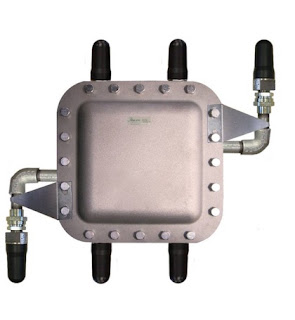Antenna – A device that converts electrical energy into propagating electromagnetic waves or the reverse.
Antenna Polarity – The orientation of the directionality of electromagnetic waves produced by an antenna. Common polarities are vertical, horizontal, and circular. Receive antennas should be oriented such that its polarity matches that of the transmitting antenna polarity.
Bandwidth – The amount of spectrum occupied by a signal. For example, a standard IEEE 802.11g transmission will use a nominal 22 MHz of bandwidth. An IEEE 802.15.4 transmission on which ZigBee, WirelessHART, and ISA100 Wireless are designed will use a nominal 5 MHz of bandwidth.
Carrier – A single frequency sinusoidal signal represented by a vertical line or spike in frequency.
Channel – A term used to identify a physical communications link and includes the characteristics of the entire path of information flow from transmitter to receiver. A channel is defined by electrical and electromagnetic characteristics of the transmission medium such as bandwidth and distortions.
Interference – RF power, typically in the RF band of interest, that disrupts communications by inhibiting the ability of a receiver to decode a transmission. Sources of interference could include anything that radiates electromagnetic (EM) energy such as machinery and undesirable radio devices.
Signal-to-Noise Ratio (SNR) – Ratio of signal power to naturally occurring emissions such as thermal noise and cosmic background radiation. Maximizing SNR is the primary goal of wireless communications.
Signal-to-Noise-And-Interference Ratio (SNIR) – Ratio of signal power to the sum of naturally occurring noise power and interference power. Minimizing the contribution of interference to SNIR is an important goal of a wireless communications system.
Power Decibels – A logarithmic representation of a voltage or power relative to a reference. Power is converted to decibels by the equation 10 P 10log p . The notation dBW and dBm represent power levels relative to 1 Watt and 1 milliwatt, respectively. The notation dB denotes a ratio of two numbers and should not be used to denote power.
Link Budget – Calculations that predict the probability that a transmission will be successfully detected and decoded by the receiver. A link budget will account for transmission power, signal formatting, noise, signal distortions, interference, receiver characteristics, and the link reliability requirements.
Link Margin – The difference in decibels (dB) between the ability of a receiver to successfully receive a transmission and the expected minimum received power. A link margin of 10 dB indicates that a signal could be attenuated by an additional factor of 10 before it can no longer be received. A link margin should accommodate reasonable unexpected attenuations, distortions, and interference not directly addressed by the link budget.
Transmitter – The device responsibility for transmitting information wirelessly.
Transmit Power – the average amount of RF energy per unit power emitted by the transmit antenna. This is typically specified in Watts, dBW, or dBm.
Bit Rate – The average or peak amount of data transmitted during an interval of time. This is represented as bits per second (bps).
Duty Cycle – The percentage at which a transmitter is active.
Modulation – The method by which information is used to modify the behavior of an RF carrier. Different modulations exist such as amplitude modulation (AM), frequency modulation (FM), and phase modulation (PM). Digital modulations are discrete versions of the above modulations. Common modulations used in industrial communications include binary phase shift keying (BPSK), quadrature phase shift keying (QPSK), and quadrature amplitude modulation (QAM), among others. Wi-Fi uses a combination of BPSK, QPSK, and QAM depending on channel quality.
Error Control Coding (ECC) – A method to increase reliability of a communications link by adding data redundancy that can detect and correct errors produced by the channel. ECC increases the amount of bandwidth requirements or decreasing the amount of useful information over a channel.
Frequency Hopping (FH) – A process by which the carrier frequency is changed during or between transmissions accordingly to a pre-defined synchronized method. With FH, transmitter and receiver must tune to the same frequency at precisely the same time. FH hopping adds a layer of complexity to a system but also makes interception or disruption of the wireless system more difficult, thereby making the system more reliable.
Spread Spectrum – A process of spreading RF energy beyond what is needed to transmit information for the purpose of improved medium access, better interference immunity, or minimization of signal detection.
Payload – The information being transmitted. The size of the payload factors into transmission duration. All communication systems have a limit to the size of a payload before fragmentation is required. Not all communication systems support fragmentation. At the lowest layers of a communication system, the payload includes all data encoding and framing.
Receiver – The device responsible for decoding incoming transmissions in accordance with an established protocol.
Received Signal Strength Indicator (RSSI) – A measurement of received signal power.
Received Signal Quality Indicator (RSQI) – A measurement of the quality of the received signal
Sensitivity – The minimum signal strength, SNR, or SNIR required by a receiver to decode an incoming transmission.
Adjacent Channel Interference (ACI) – RF energy that is adjacent to the channel containing a desired signal.
Adjacent Channel Rejection (ACR) – The ability of the receiver to suppress ACI.
Dynamic Range – The difference between the maximum and minimum received signal power. A large dynamic range is particularly helpful in accommodating strong ACI that leaks past RF filtering.
Selectivity – The ability of a device to decode a transmission on one frequency without interference from transmissions on other frequencies.
Reprinted from Guide to Industrial Wireless Systems Deployments by the National Institute of Standards and Technology.
(614) 755-5091






